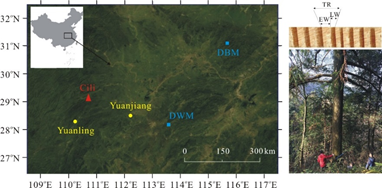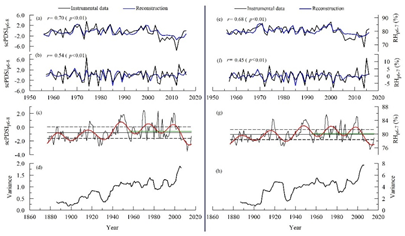Hydroclimate is an important part of the global climate system. Its extreme changes (drought, flood) can have disastrous effects on socioeconomic security and ecosystem function not only in arid to semi-arid areas, but also in humid areas.
How hydroclimate will change in the future has been of great interest with the increasing concern of global warming. Acquirement of ample high-resolution proxy-based reconstructions will aid to answer such question by increasing the accuracy of climate prediction models. However, discrepancies among existing reconstructions have aroused great uncertainty about the hydroclimatic conditions.
Since July in this year, extreme heavy rainfall events in Henan, Shaanxi and Shanxi provinces have caused huge losses of people's lives and property. These extreme climate events have also sounded the alarm of climate change again. There is an urgent need for high-quality and reliable climate prediction, which also poses a higher challenge to high-resolution palaeo-hydroclimatic researches.
Recently, a research group from Institute of Earth Environment, Chinese Academy of Sciences, presents an annually-resolved June–August scPDSI reconstruction and a June–July relative humidity reconstruction from 1876 to 2015 in the middle reaches of the Yangtz River, based on accurately-dated tree-ring materials.
The reconstructions well reproduce the instrumental records, with explained variance of 48.82% and 46.79%. A secular wetting trend is found in the study area from 1876 to 2000, then it dried quickly. The driest (2006–2015) and wettest (1943–1955) periods both occurred after 1940, and 40% of the top 10 driest years occurred in the 21st century.
Overall, an increasing intensified hydroclimatic variation is identified, especially significant in the recent decade. The historical summer hydroclimatic variation, which were found closely related to the concurrent temperature variations, might be a comprehensive effect of Pacific Decadal Oscillation (PDO), Western Pacific Subtropical High (WPSH) and El Niño-Southern Oscillation (ENSO) variations.
The reconstruction provides additional support not only for a comprehensive understanding of the spatiotemporal characteristics of hydroclimatic variations, but also for the diagnosis and prediction of hydroclimatic anomalies.

Fig. 1 Overview of the study area
Cili is the sampling site (red triangle), Yuanling and Yuanjiang are the meteorological stations (yellow dots), Daowu Mountain (DWM) and Dabie Mountains (DBM) are the compared sites (blue squares). TR, EW and LW represent tree ring, early wood and late wood, respectively. (Image by CAI, et al)

Fig. 2 Reconstruction of June–August scPDSI (scPDSIp6–8; left panel: a–d) and June–July relative humidity (RHp6–7; right panel: e–h) in Cili, subtropical China (Image by CAI, et al)
(a) and (e) are comparisons between the reconstructed (blue) and the instrumental (black) records. (b) and (f) are comparisons between the first-order difference sequences of (a) and (e). (c) and (g) are the reconstructed scPDSIp6–8 and RHp6–7 from 1877 to 2016. (d) and (h) are the 21-year running variance of the reconstructed scPDSIp6–8 and RHp6–7. The black curve in (c) and (g) indicates the annual variation, the red curve indicates the 20-year lowpass filter. Horizontal lines indicate the mean value of the reconstruction over 1877–2016 (black) and the instrumental period (green). Dotted lines indicate mean±1σ (standard deviation).
This work, published online in Climate Dynamics on October 20, 2021, was supported by the Strategic Priority Research Program of Chinese Academy of Sciences (XDB40010300), the National Natural Science Foundation of China (41671212) and the State Key Laboratory of Loess and Quaternary Geology foundation (SKLLQG).
Contact: Bai Jie, Institute of Earth Environment, Chinese Academy of Sciences, Xi'an, China. Email: baijie@ieecas.cn
 © 2015 Institute of Earth Environment,CAS
© 2015 Institute of Earth Environment,CAS Address:No. 97 Yanxiang Road, Xi'an 710061, Shaanxi, China

 Location :
Location :